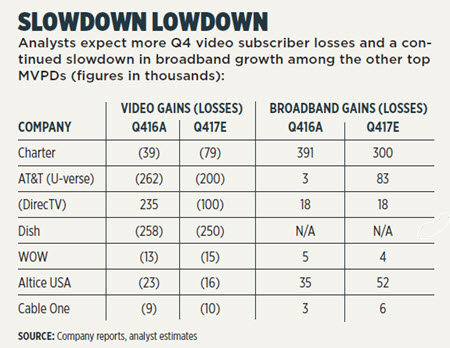Cable Ops Find Silver Lining in Q4 Declines

When the number of customers decline for a business, it’s always bad news. But in the cable industry, if subscribers aren’t leaving as quickly as they did in the last quarter, well — that’s good news, right?
While the ongoing trends of video subscriber losses and slowing broadband additions continued, they weren’t as bad as expected. And in this volatile media climate, that can be good enough.
Comcast’s 33,000 video losses in the fourth quarter were better than many had expected — consensus was for a loss of about 45,000 — but it was a reversal from last year’s gain of 80,000 customers. In what is usually a seasonally strong quarter, Comcast fell short. For the year, its video customers were down by about 150,000, nearly erasing the 161,000 video subscribers it added in 2016.
While the video declines seem to make a strong case for the growing impact of cord-cutting, the financial picture tells another story. Comcast grew cable revenue by about 3.4% in the period, a respectable level given the continued subscriber decline. Cash flow was up a strong 4.2%, and free cash flow — basically cash flow minus capital expenditures — was on pace to rise 8.2% this year. That, according to Moffett Nathanson principal and senior analyst Craig Moffett, is unprecedented.
Cost Curbs Boost Cash Flow
According to Moffett, Comcast is making accelerated video subscriber losses — and a slowing of its broadband additions — work by keeping its other costs down. One need only look at margin growth for proof. Comcast’s 40.7% cash-flow margins in the quarter were 40 basis points higher than consensus and 30 basis points above last year.
And while other operators are expected to report revenue growth in the 2% to 3% range and cash-flow increases approaching 4%, video losses are not expected to slow down soon.
“By now, the litany of worries that has kept investors on the sidelines should be familiar to everyone,” Moffett wrote. “Video subscribership is being hammered by cord-cutting. Video margins are being squeezed by [virtual multichannel video programming distributors]. Broadband industry growth is hitting a wall. AT&T is expanding its fiber footprint. Verizon is deploying 5G fixed wireless. Cable’s growth phase must surely be over.”
Even Comcast admits that the pressure isn’t expected to let up.
But Comcast’s better-than-expected numbers are at least somewhat encouraging, especially since it was able to post strong financial results.
“How many companies growing revenues by 4%-plus have free cash flow yields of 8%-plus?” Moffett asked.
Comcast said it is combating the competition through new products like its wireless offering — which has more than 380,000 customers, but is not yet profitable — and Instant TV, its streaming video offering, as well as innovative video bundling and broadband packaging. On the minus side, Comcast could be the exception to the rule — its Q4 video subscriber losses represented less than 1% of its base. The rest of the industry has been shedding video customers at a 3.5% clip.
Verizon Communications’s Fios TV offering shed 29,000 customers in the quarter, compared with a gain of 21,000 in 2016, reflecting “the shift from traditional linear video to over-the-top offerings,” the company said.
Verizon has reportedly been focusing on its own OTT offering. The company didn’t mention that product on last week’s conference call, but most analysts believe it will launch in the spring. Whether that means the company will focus less on its landline Fios TV business — subscribers are down to about 4.6 million, from 4.7 million at the beginning of 2017 — and more on its streaming offering, remains to be seen.
OTT Growth to Cool Down
Over-the-top providers are expected to continue to disrupt the pay TV model, but more established players should begin to see their growth rates start to slow. Evercore ISI Group media analyst Vijay Jayant predicted a slight fall off for Dish Network’s Sling TV in Q4, to 250,000 additions from 286,000 in the prior year, but UBS telecom analyst John Hodulik estimated Sling TV’s growth would be cut in half, to about 100,000.
For other cable operators, the fight will be a mixture of the same — higher video subscriber losses, slower broadband gains and accelerated efforts to cut costs.
That means most analysts expect AT&T, the next big distributor up to the earnings plate on Wednesday (Jan. 31), to see further video customer erosion.
Jayant predicted AT&T would shed about 300,000 video customers at its DirecTV and U-verse TV units in the quarter, up from a loss of 27,000 subscribers in the previous year. Hodulik was slightly less optimistic, predicting fourth-quarter losses of about 330,000 subscribers.
Charter Communications, which is scheduled to report fourth-quarter results on Friday (Feb. 2), is expected to lose about 79,000 video subscribers while its broadband growth slows to about 300,000 additions, down from around 360,000 in the previous year.
Multichannel Newsletter
The smarter way to stay on top of the multichannel video marketplace. Sign up below.
